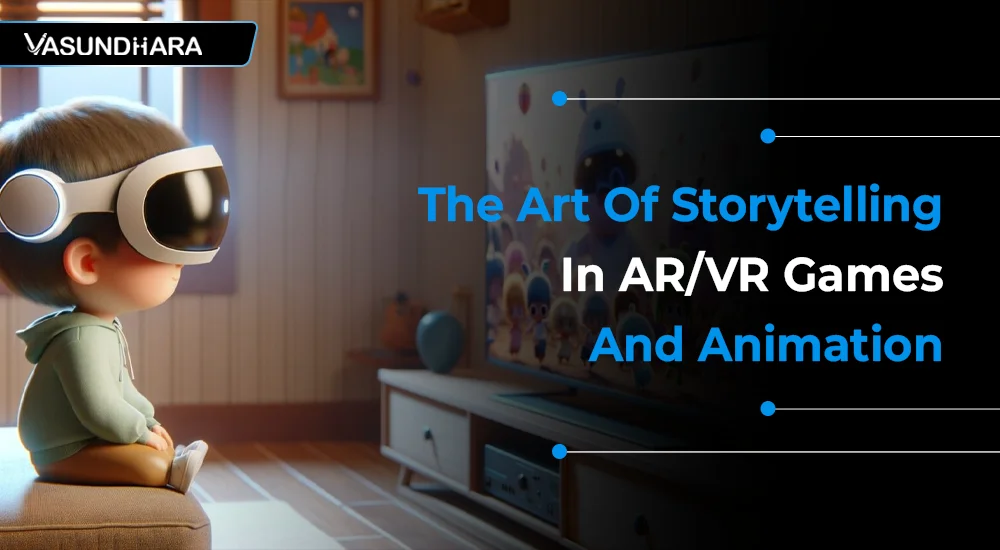The Art Of Storytelling In AR/VR Games And Animation


- Jan 29, 2024



With the introduction of Augmented Reality (AR) and Virtual Reality (VR) technology, the worlds of gaming and animation have undergone a dramatic upheaval.
As augmented reality and virtual reality continue to gain traction in the entertainment business, it becomes increasingly important to investigate the complexities of narrative within these immersive mediums.
Storytelling has always been at the heart of memorable and captivating experiences. Narratives have the capacity to transport viewers to new worlds, elicit emotions, and leave a lasting impression, whether through literature, cinema, or conventional sports.
In the context of AR/VR, storytelling is critical to improving the immersive aspect of these experiences and making them more engaging and memorable.
This blog digs into the growing environment of storytelling in Augmented Reality (AR) and Virtual Reality (VR), with the goal of identifying the unique challenges and opportunities that occur when crafting narratives for these immersive technologies.
Historically, animations and video games have utilized linear narratives to tell stories to their audiences.
By regulating the sequence of events, developers were able to direct the audience or participant along a pre-established narrative path.
On the contrary, the emergence of video games precipitated a transition towards interactive storytelling, endowing players with control and options that might modify the progression of the story.
The incorporation of interactive elements into video games has significantly expanded the paradigm of storytelling.
The ability of players to solve puzzles, make decisions, and affect the course of the narrative results in a more engaging and individualized experience.
This development paves the way for comprehending how AR/VR can revolutionize interactivity.
The challenges of storytelling in Augmented Reality (AR) and Virtual Reality (VR) are specific to these disruptive technologies.
Addressing these issues is critical for creating captivating narratives that fully utilize the power of AR/VR animation in gaming.
The immersive nature of Augmented Reality (AR) and Virtual Reality (VR) presents a unique challenge to narrative.
Unlike traditional mediums, Augmented reality stories immerse consumers in the story, necessitating a fluid approach.
Creators must adapt to users actively exploring the virtual environment, which necessitates the use of novel techniques to direct attention and maintain coherence.
The interactivity of AR/VR not only grants users power but also necessitates a careful equilibrium between user autonomy and a captivating narrative.
The preservation of narrative profundity while managing user choices presents a challenge for storytellers as they strive to uphold emotional resonance and pacing in the absence of conventional control.
Technical limitations in graphics, processing power, and accessibility impact AR/VR animation.
Navigating these constraints demands creativity to ensure visually immersive experiences across devices and continuous adaptation to evolving technologies, placing storytellers at the intersection of innovation and narrative craft.
AR/VR technologies provide users with the exceptional opportunity to experience a profound sense of presence and agency.
By incorporating interactive components and authentic settings, developers have the ability to immerse users in the narrative and encourage them to take an active role, thereby intensifying the emotional resonance of the story.
A unique characteristic of AR/VR, spatial storytelling permits developers to employ physical space as a means to communicate narrative components.
This provides a level of immersion that is unattainable in conventional media, as the environment itself becomes a canvas upon which narratives unfold. This introduces new dimensions to storytelling.
Augmented reality and virtual reality provide the medium for non-linear narratives, allowing creators to delve into stories that encompass various viewpoints and deviate from the main course.
By adopting a dynamic storytelling approach, the replay value is increased and users are motivated to delve into various aspects of the narrative, resulting in a one-of-a-kind experience.
The establishment of connections between users and the characters they inhabit is a fundamental element of narrative construction.
AR/VR encounters its greatest obstacle in the creation of likable characters that cultivate a connection that transcends the physical world within the virtual environment.
Character interaction is afforded distinct opportunities by the interactive nature of AR/VR. By interacting with virtual characters in unconventional ways, users can forge more profound emotional bonds and experience a heightened sense of immersion.
In AR/VR storytelling, overcoming the obstacles of evoking genuine emotions in a virtual environment is a crucial component.
It is critical to comprehend the intricacies of emotional attachment and compassion within these immersive encounters in order to construct narratives that have a profound effect.
Narrative design tools play a pivotal role in crafting immersive stories for AR/VR.
These tools, ranging from interactive storyboarding platforms to spatial design software, empower storytellers to structure branching narratives and create dynamic, user-driven experiences.
In a 360-degree space, directing user attention becomes paramount.
Techniques such as spatial audio cues, visual focal points, and intuitive design are employed to guide users seamlessly through the narrative, ensuring they don't miss crucial story elements in the expansive virtual environment.
Harmonizing visuals, audio elements, and interactive components is essential for a cohesive AR/VR narrative.
Striking the right balance ensures that the immersive experience remains engaging, emotionally resonant, and aligned with the intended narrative arc, creating a seamless fusion of technology and storytelling.
New technologies like AI, haptic feedback, and advanced models will play a big role in the future of AR/VR storytelling.
These new ideas will change the ways stories can be told by making them more dynamic, flexible, and personalized so that they change based on how the user interacts with them and how they feel.
The future of AR/VR stories will be shaped by how well storytellers, game makers, and tech experts work together.
A multidisciplinary approach helps make virtual worlds where interesting stories and cutting-edge technologies work together smoothly. This pushes the limits of what is possible in immersive storytelling.
When you think about the future, you have to imagine enhanced user experiences, settings that are too real, and story structures that change based on what the user does.
Immersive storytelling is going to become more interactive, emotionally engaged, and a big part of our digital lives as AR and VR technologies improve.
Being the best game development company in India, Vasundhara Infotech specializes in developing immersive games by utilizing AR/VR animation.
As a result, the investigation into AR/VR storytelling has unveiled a terrain brimming with obstacles and prospects.
The foundation for shaping the future of immersive experiences continues to be narrative. The future of AR/VR technologies will be significantly influenced by the way in which users interact with virtual environments and characters through the medium of storytelling.
The dynamic and perpetually changing realm of narrative in augmented reality/virtual reality (AR/VR) games and animation provides an expansive platform for ingenuity and advancement.
Due to its profound understanding of immersive technologies, Vasundhara Infotech is a significant contributor to the development of narrative techniques in AR/VR games and animation.
With the assistance of collaborative efforts and state-of-the-art tools, Vasundhara Infotech has the capability to assist storytellers in materializing their narratives within the immersive domains of VR and AR story.
Creators who are interested in exploring the potential of AR/VR storytelling or who are seeking to improve their current projects are cordially invited to collaborate with Vasundhara Infotech.
Contact us today to fully harness the capabilities of storytelling within the enthralling realm of AR/VR.
Request for quotes for FREE now!
Copyright © 2026 Vasundhara Infotech. All Rights Reserved.